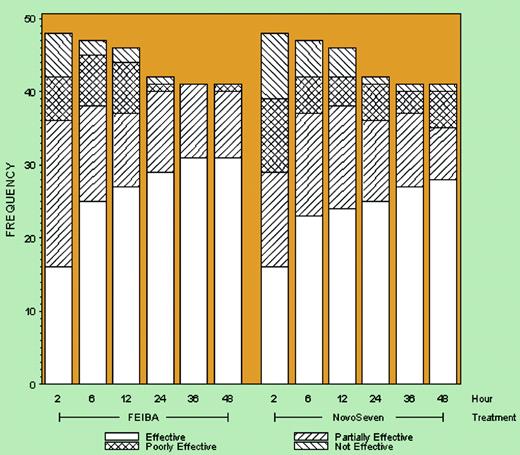Astermark and colleagues report in this issue of Blood on the first prospective, crossover comparison of the 2 bypassing therapies available for treating hemarthroses in subjects with high-responding factor VIII or IX antibodies: recombinant factor VIIa (rFVIIa) and FEIBA, an activated prothrombin complex concentrate (aPCC).
The virtual elimination of pathogen risks for clotting factor concentrates (CFCs) leaves the development of inhibitors (particularly anamnestic neutralizing antibodies against factor VIII or factor IX) as the foremost complication of hemophilia therapy. No effective strategy yet exists to preempt this adverse outcome. With unresponsiveness to factor VIII/IX replacement therapy, alternative strategies to treat bleeding are essential. At present, the most viable option for these patients is a bypassing hemostatic agent that enhances thrombin generation/clot formation when FVIII/IX-dependent thrombin amplification is blocked.
Two bypassing agents are presently available: rFVIIa and an aPCC, FEIBA.1,2 One or both typically constitute the primary hemostatic therapy for inhibitor patients. For hemarthroses, the choice of which agent to use has most often been made based on patient or physician preference.
In the study by Astermark and colleagues, an equivalence design is used to examine whether the 2 bypassing options are statistically “equivalent” for treating hemarthroses in inhibitor subjects. Each subject was randomized to treat successive elbow, ankle, or knee hemarthroses alternately with FEIBA or rFVIIa, regardless of which joint was involved. Randomization was expected to control for any differential response across the entire cohort. One dose of FEIBA (approximately 85 units per kilogram body weight) was compared with 1 or 2 doses of approximately 100 μg/kg rFVIIa. Therapeutic equivalence was defined as equal hemostatic efficacy (effective/partially effective as rated by the patient) ± 15% variation. By this predetermined definition, the 2 drugs were not equivalent at any of the postinfusion time points. The figure gives the efficacy response for the 2 drugs at the respective posttreatment assessments.
Frequencies (counts) of efficacy outcomes by time point and type of treatment. See the complete figure in the article beginning on page 546.
Frequencies (counts) of efficacy outcomes by time point and type of treatment. See the complete figure in the article beginning on page 546.
Although there is no statistical equivalency between FEIBA and rFVIIa (with the former demonstrating greater “effective/partially effective” responses at several time points), the authors do not infer that a single dose of aPCC is superior to 2 doses of rFVIIa for hemarthroses. They point out that exploratory analyses to assess superiority of one product over the other failed. Somewhat reassuring is that both had efficacy rates of 80% to 90% at some time points, which is consistent with published results.
The authors also tried to identify confounders that might explain nonequivalency. These include discordant joints treated in the 2 arms, diverse geographic treatment practices, lack of patient blinding to his treatment, and a 20% attrition rate in the intention-to-treat analysis. None explained the nonequivalency. One variable that did significantly influence efficacy but not in a differential way for the 2 drugs was a previous history of more frequent hemarthroses: subjects with more frequent hemarthroses in the 6 months preceding the trial (and by inference, likely with worse hemarthropathy) demonstrated inferior clinical responses to either. However, this group also had greater discordancy in its response to the 2 drugs. The degree of synovitis may influence whether any bypassing strategy is successful. Ameliorating this iron-induced synovitis is a tall order for any therapy that does not achieve normal thrombin-generating capacity.3 Individual variations along the biologic continuum from normal to severe joint injury may influence the responsivity to 2 drugs that work differently to initiate a thrombin burst in the hemarthritic joint.4
Conflict-of-interest disclosure: The author is a consultant for and receives research funds from Baxter and Novo Nordisk, the makers of the biologic products compared. ▪


This feature is available to Subscribers Only
Sign In or Create an Account Close Modal